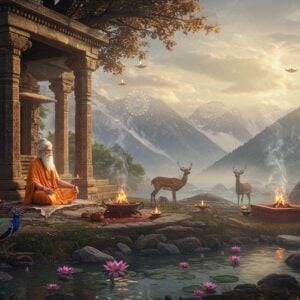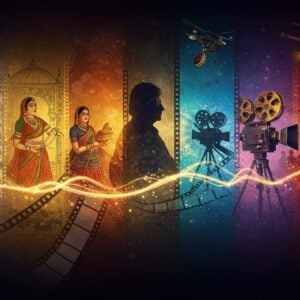
Indian art and culture are deeply intertwined with the Dashavatara, the ten divine incarnations of Lord Vishnu. These avatars hold profound spiritual significance and convey essential moral and spiritual lessons. The diverse artistic representations of the Dashavatara celebrate Vishnu’s role as the preserver in Hindu mythology. Exploring these themes connects individuals to their cultural heritage, offering traditional yet accessible ways to engage with these rich traditions. For those seeking to deepen their understanding of Lord Krishna, Poojn.in offers a wealth of resources and products. Delve into the symbolism of Krishna’s flute here and explore the intricacies of his ten avatars here.
Dashavatara in Painting: A Vibrant Tradition
Dashavatara paintings boast a rich tradition across various regions of India. Each region showcases a unique style, such as the intricate details and vibrant hues of Pattachitra from Odisha. These paintings vividly depict the life and deeds of each avatar, often employing natural dyes and traditional techniques that imbue them with authenticity and historical significance. Contemporary artists continue to reinterpret the Dashavatara, blending traditional forms with modern aesthetics. Prominent artists and exhibitions have brought these paintings to the forefront, influencing interior design trends. Online art galleries now offer a convenient way to explore and acquire these captivating artworks. You can find exquisite examples of Dashavatara art and create a dedicated Krishna altar in your home. Learn how to create a Krishna altar.
Dashavatara Rangoli: Ephemeral Beauty and Symbolism
Rangoli, a cherished Indian art form with deep cultural roots, is often created during festivals and rituals. The Dashavatara finds symbolic representation in Rangoli designs during auspicious occasions. The materials and techniques employed produce intricate patterns, highlighting their transient beauty. Regional variations abound, and Rangoli competitions keep this art form vibrant and engaging. Rangoli also plays an educational role, conveying mythological stories to younger generations through artistic expression. Digital platforms now incorporate Rangoli into virtual cultural festivals, broadening its reach and impact. Celebrate Krishna’s presence in art forms like paintings, drawings, and Rangoli here.
Dashavatara in Dance: Stories in Motion
Classical Indian dance forms like Bharatanatyam, Kathak, and Odissi bring the Dashavatara to life on stage. Renowned dance productions and choreographers skillfully narrate the stories and teachings of these avatars through expressive movements. Costumes, makeup, and music enhance the storytelling, creating immersive and captivating performances. Dance festivals and competitions play a crucial role in preserving and popularizing these art forms. Online platforms stream and promote Dashavatara dance performances, making them accessible to a global audience. Immerse yourself in the devotional world of Krishna Bhajans here.
Cultural Festivals Celebrating the Dashavatara
Cultural festivals such as Navratri and Diwali honor Vishnu’s avatars through various art forms, including dance and music. Specific regional festivals focus on particular avatars, like Onam in Kerala, which celebrates Vamana. Community activities and rituals during these festivals strengthen cultural bonds and transmit traditions across generations. While globalization influences these traditional festivals, adaptations for the digital age ensure their continued relevance and vibrancy. Cultural organizations play a vital role in preserving these traditions for future generations.
Vishnu’s Iconography and the Dashavatara
Vishnu, a principal deity in Hinduism, is revered as the protector and preserver of the universe. He descends to Earth in various forms, known as avatars, to restore cosmic balance and uphold dharma. These avatars are depicted in art, architecture, literature, dance, music, and other performance traditions throughout South Asia and beyond.
- Blue Skin and Divine Attributes: Vishnu is often depicted with blue skin in paintings. In sculptures and architecture, where color might not be apparent, he is identifiable by his attributes: a conch shell, a discus, a mace, and a lotus flower. These symbols represent different aspects of his divine power and cosmic role. The conch symbolizes the primordial sound of creation, the discus represents the cycle of time, the mace signifies Vishnu’s power to uphold dharma, and the lotus represents purity and spiritual awakening.
- Consorts and Companions: Vishnu is frequently portrayed with his consort, Lakshmi, the goddess of fortune and prosperity. Sometimes, he is depicted with two consorts: Shri Devi, representing auspiciousness, and Bhu Devi, representing the Earth. His animal mount and loyal companion is Garuda, a mythical creature that is part man and part eagle, symbolizing speed, strength, and devotion. Garuda’s presence signifies Vishnu’s power to transcend limitations and reach any part of the universe to protect his devotees.
The ten incarnations of Vishnu, collectively known as the Dashavatara, often share his blue skin but each possesses unique talents, personalities, and iconography. They evolve from animal forms to human forms as the cycles of time progress, reflecting the increasing complexity of life and consciousness.
Poojn.in offers a wide variety of spiritual and religious products that can enhance your connection to the Dashavatara and other Hindu deities. Explore our collection of Laddu Gopal idols, Radha Krishna idols, and other deity statues to create a sacred space for worship in your home.
The Ten Avatars: From Matsya to Kalki
- Matsya (The Fish): Rescued the sacred Vedas and Manu from a great flood, symbolizing preservation of knowledge and life.
- Kurma (The Tortoise): Supported Mount Mandara during the churning of the cosmic ocean, representing stability and strength.
- Varaha (The Boar): Lifted the Earth from the depths of the ocean, symbolizing the rescue of the world from chaos.
- Narasimha (The Man-Lion): Vanquished the demon king Hiranyakashipu, representing the triumph of good over evil.
- Vamana (The Dwarf): Dethroned the demon king Bali, symbolizing humility and cosmic balance.
- Parashurama (The Warrior with the Axe): Rid the world of corrupt rulers, representing justice and righteousness.
- Rama (The Prince of Ayodhya): Defeated Ravana and restored dharma, embodying virtue and moral leadership.
- Krishna (The Divine Cowherd): Guided the Pandavas and imparted wisdom, symbolizing divine love and guidance.
- Buddha (The Enlightened One): Spread teachings of compassion and enlightenment, representing spiritual awakening.
- Kalki (The Future Warrior): Will descend to restore dharma in the age of Kali Yuga, representing hope and ultimate justice.
Representations of Vishnu’s avatars are found not only in traditional art forms but also in everyday objects like Ganjifa cards, introduced to India by the Mughals, further illustrating their pervasive influence on Indian culture.
FAQs: Understanding the Dashavatara
What does Dashavatara mean? Dashavatara translates to “ten avatars” and refers to the ten primary incarnations of Lord Vishnu. These avatars appear throughout different cycles of time to restore balance and dharma.
How are the Dashavatara depicted in art? Each avatar has unique characteristics and symbols in art. Matsya is often shown as a fish or fish-human hybrid. Kurma is depicted as a tortoise. Varaha appears as a boar. Narasimha is a fearsome half-man, half-lion figure. Vamana is typically a dwarf or sometimes a giant. Parashurama is a warrior with an axe. Rama is a regal figure with a bow and arrow. Krishna is often shown with a flute. Buddha is portrayed in meditative poses. Kalki is depicted as a warrior on a white horse, wielding a flaming sword.
What is the significance of the Dashavatara in Hinduism? The Dashavatara embodies the cyclical nature of time and the continuous struggle between good and evil. It signifies Vishnu’s role as the preserver and highlights the importance of upholding dharma. Each avatar’s story teaches moral and ethical lessons.


